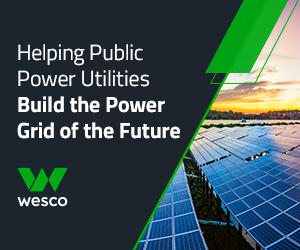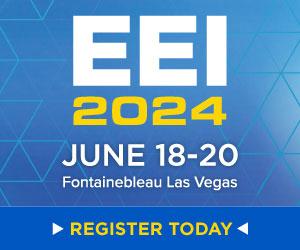Electrifying Industrial Processes
Steve Mitnick is Editor-in-Chief of Public Utilities Fortnightly and author of the book “Lines Down: How We Pay, Use, Value Grid Electricity Amid the Storm.”
Public Utilities Fortnightly visited EPRI's Charlotte labs on September 25. Very cool. We met scientists working on leading edge technologies for electrifying industrial processes particularly and other sectors of the economy as well.
Non-Destructive Test
One of the things we're doing here is non-destructive testing. Non-destructive testing is when you try to evaluate the integrity of the different component without actually cutting it open or digging into the component. This is a method that's used in pretty much all of the power plants, and also in other industries.
One of the methods that we use the most is called ultrasonics. You're probably familiar with ultrasonics. Ultrasonics is used for a lot of different things. It's used to clean jewelry, it's used in sonograms to create images, and we use the same technology to also look at the integrity in components in power plants.
Robot Welder
It's basically like a semi-robotic, remote controlled welding application. We use it because it is super repeatable and we can track all of our data. We have a commanded set of perimeters and we also get that feedback of actual perimeters, as well as times and positions and all kinds of stuff, so we can use that real data to help in our models and calculations of heat input, stresses and all that stuff.
Cool Shop
This helps us with the fatigue aspect so we can keep jamming out long days and get good consistent welds. We also have a wave, so there's the spin the part, weld on a part, that kind of thing. We don't have it set up now, but we also a vision system with a touch screen interface so we can record video as well as graphical and numerical data all at the same time coming off this machine. Then we can compile those in a presentation to say, "Hey, this is what the weld looks like." If we go through inspection and come across something, we can track that back to the data, graphical and numerical, and the video and try to figure out what might be going on.
Finding Defects
This is basically an oscilloscope, and you also need a transfixer like this one here. Inside this case is a piece of electric crystal and since this piece is electric, when you apply a voltage to it, it vibrates. In ultrasonics what we do is this instrument applies a voltage to the crystal, it vibrates and sends a sound wave throughout the component that we're testing, and that helps us to determine whether we have any defects in that component.
Generally, how we do that is by looking at this display here, which is called an A-scan because it shows the amplitude of the sound wave as it travels through the component. If you look at this screen here, as I put this sensor on this component, you see that I get a signal here. I get a signal from the back wall of this particular component. What you would do in your ultrasonic test is look at this A-scan, moving the sensor around and trying to determine if you have any anomalies or any integrity issues throughout that component.
Duo Lasers
Once the heat input from the main laser ... as it passes by, you want this other laser to continue to warm that area so that it doesn't just ... it cools down, but controlled. You don't want that quick cooling. Right? You want to be able to control the cooling, and that's what the secondary laser does.
Super Microscope
Right now, he's got it at 100,000 X magnification, and he is really close up. He's trying to find ... he's looking at coatings that are along here in oxide layers. It can also, along with EDACS, it will shoot the beam on an area, and it will tell you what your microstructure is.
Microstructure 1
Here's a weld that I polished and etched, it brings out the microstructure here, which he wants to see ... It brings out the weld beads, plus the microstructure where you can't really see it in this picture because I haven't captured it yet, but that's what I do in here. I polish samples to a mirror image so you can see yourself, and then I etch 'em so you can see microstructure, weld beads, whatever the person wants to see, and I take pictures of 'em.
Microstructure 2
One of them has lack of fusion in it, and this should be one of them. Let me see if I can show you that. And this machine is awesome, because it stitches everything for you. All you have to do is focus and guide the little square. And there is some lack of fusion in this one here.
Electrifying the Workplace
Public Utilities Fortnightly sat down with Baskar Vairamohan at EPRI's Charlotte Labs and talked about the potential for further electrifying the industrial and commercial sector.
Process Heating
In the industrial technologies, process heating is a major energy user. Currently, the conventional methods heat the air, and the hot air heats the part. With electric technology, such as infrared heating, the heat is directly applied to the part by increasing the thermal efficient going to the part.
Also, if the plant has a conventional oven, the process can be improved and the productivity of the plant can be improved by adding an electric booster oven in place of the traditional convection oven.
Airports
When we are looking at electrification technologies, industrial, commercial, and even large commercial facilities like airports can benefit from the electrification technologies. When you look through the windows of an airplane you see baggage pushers or baggage tractors, plane pushers and other technologies that could be easily electrified with the current existing commercially available technologies that can not only help the customers but reduce emissions and help the community as a whole in reducing noise pollution and emissions.
Electrifying the Home
Public Utilities Fortnightly sat down with Tom Reddoch at EPRI's Charlotte Labs and talked about the potential for further electrifying the residential sector.
Shaping AC & DC
Part of our research is focused on the issue of, what is the best format, or how should we shape the voltage and current so that electricity can be a best use to electrify in use loads. In some cases, this could be alternating current, something other than sixty hertz. It could be a pulsed format like in pulsed DC. In lighting, we might go to a somewhat different format.
If we could look at something like a Category 5 distribution for power ethernet, that also allows us to look at other in use loads like computers and thermostats. Outside of that, we could even look at things like DC street lighting where we bring a DC as a service, do a single step down from the medium distribution DC to some kind of in use load, twenty-four-volt, twelve-volt DC, kind of to be determined, and we power our street lights off of DC directly.
Energy Future
As we begin to look at the practice of what we would call the integrated energy network, we're looking at a situation where we're trying to use all of our resources in a most efficient way. In particular, this results in us using electricity in appropriate applications as well as natural gas and other fuels in order to meet our collected energy need.
As a part of that effort, as we focus on efficiency for meeting our energy needs, our efforts to include renewables and that entire equation is best achieved by getting it in an electric form. In order to balance out the full equation, what we should also do is look at water because water makes up part of our total natural resource base and our objective is good energy efficient solutions that minimize the amount of water to carry out the transaction.
Lighting
That reduction has come about by displacing the incandescent bulb with CFLs. This resulted in a significant reduction in overall energy use, about seventy-five percent for a given app. Just as we thought maybe we had been quite successful with our lighting energy efficiency efforts, LEDs began to appear.
With that advancement, we're potentially able to remove as much as ninety percent of the amount of lighting, energy used in lighting. Along with this, with these much lighter lighting loads, the amount of infrastructure that's built into buildings to service or fix lighting can also be reduced.
We don't need twelve-gauge wire. We can accomplish that with a much lighter gauge wire, and in many cases, this does not even require an electrician to install this.
EV Charging
Let me just share a little with you about the charging of electric vehicles. We're interested in achieving fast charging.
One of the ways that we're doing this is actually using DC at the site of where the vehicle, or perhaps an off-road vehicle, might be charged in a much faster way. Today that current thinking is that the utility delivers AC through the meter, and at the customer location a device is used to change the AC into DC to operate the charger.
Going forward there are discussions about perhaps utilities should consider establishing a DC service. In that scenario, the DC could be shifted to the utility side of the meter, and the utility deliver the electric service as DC.
More on EV Charging
For fast charging, we are having increasing conversations that the level of power that might be used is of the order of two hundred to three hundred kilowatts DC. As we continue to advance this DC charging concept it is entirely possible that we could have as much as a megawatt of power being supplied at DC. This could be a master station to charge several vehicles.




